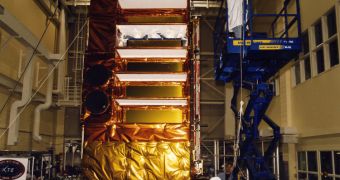After providing scientists with new insights into the nature of environments surrounding some of the weirdest structures in the Universe, the NASA Rossi X-ray Timing Explorer (RXTE) spacecraft was finally retired from active duty on January 5, after 16 years of service.
The probe far exceeded its planned lifespan, and produced vast amounts of scientific data. Its contributions are made all the more important by the fact that its instruments were always focused on studying white dwarfs, neutron stars and black holes.
RXTE was in charge of observing the time structure of astronomical X-ray sources. That is to say, it could analyze multiple aspects of how these intense light radiations were formed, how they traveled, how they were influenced by their environment and so on.
Data produced by this mission were used for a number of breakthrough studies, such as for example confirming the smallest black hole ever discovered, and identifying the first, intermediate-mass black hole. It also found that galactic X-ray glows are also produced by white dwarfs inside these structures.
Given its tremendous contributions to science, experts at the NASA Goddard Space Flight Center (GSFC), in Greenbelt, Maryland, had a hard time deciding to pull the plug on the mission. The last data were sent to the ground on January 4, and the satellites was successfully decommissioned on January 5.
In practical terms, RXTE's contribution to the field of astronomy can be found in more than 2,200 research papers in refereed journals, 1,000+ rapid notifications distributed throughout the international astronomical community as an X-ray phenomenon was happening, and 92 PhD thesis.
“The spacecraft and its instruments had been showing their age, and in the end RXTE had accomplished everything we put it up there to do, and much more,” GSFC RXTE project scientist Tod Strohmayer explains.
Tests conducted after January 5 confirmed that the spacecraft had shut down, and that none of its systems had autonomously reengaged. The vehicle is now at the mercy of solar activity, in the sense that the latter's intensity will determine when RXTE reenters the atmosphere.
This is expected to take place sometime between 2014 and 2023, investigators say. At this point, there is no way of knowing for sure when this might happen.
The spacecraft launch on December 30, 1995, from the Cape Canaveral Air Force Station (CCAFS), in Florida, aboard a Delta II 7920 rocket. Originally, it was simply called the XTE.
“It was renamed RXTE in early 1996 in honor of Bruno Rossi, an MIT astronomer and a pioneer of X-ray astronomy and space plasma physics who died in 1993. RXTE,” a NASA press release explains.

 14 DAY TRIAL //
14 DAY TRIAL //